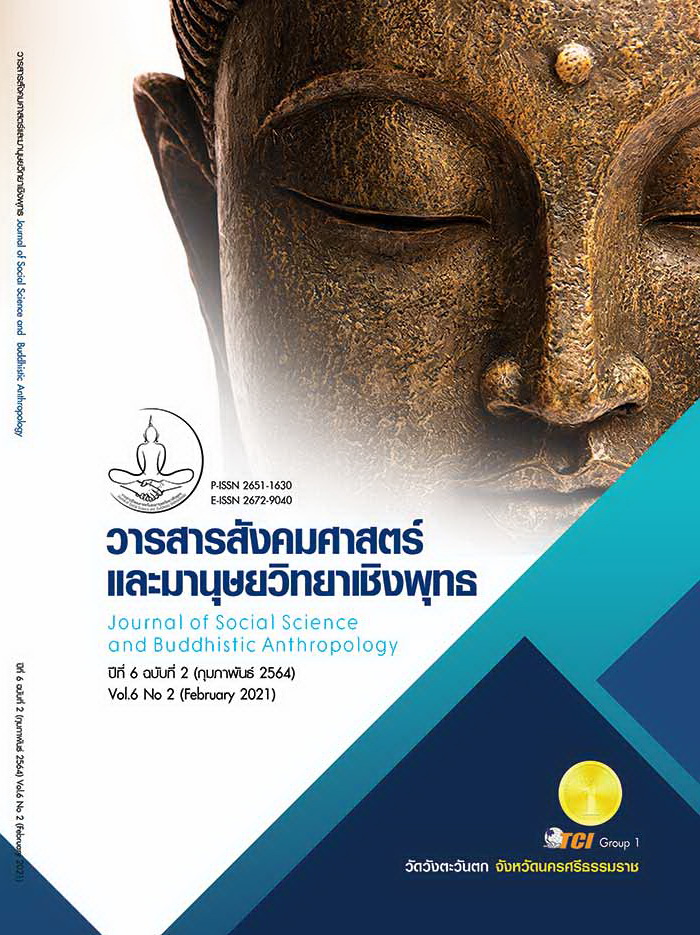INNOVATIVE TREATMENT OF CHRONIC WOUNDS FOR PREVENTION OF DISABILITY IN DIABETIC PATIENTS WITH HERBAL MEDICINE AND BUDDHIST WAY
Keywords:
Innovation, Chronic Wound, Diabetic Patient, Herbal Medicine, Buddhism - Based TreatmentAbstract
The objectives of this article were 1) to study components and properties, in both scientific and traditional, of medicinal plants, can use as herbal medicines. 2) to treat chronic wounds, to develop medicinal plants as an innovative treatment for chronic wounds to prevent disabilities of diabetic patients. 3) to analyze the achievements of the innovation. Selected specific research area, in Maha Sarakham and Roi Et Province, studying 40 chronic diabetic patients. Data were collected through active observation, in-depth interview, use monofilament to test for assessing feet sensations and chronic wound evaluation. Analyse data by content analysis method. The research results indicated that, 19 medicinal plants has properties to solve blood, vascular and lymphatic problems, reduce blood viscosity, clean blood vessels, drain lymph fluid from wounds, reduce inflammation and heal wounds. So develop them to an innovation treatment of chronic wounds, as 5 herbal medicines, use them to treat chronic wounds of the patients. The researcher is also applying the Buddhist principles in the process, applied to the patients while participating in the research project. The chronic wounds of the diabetic patients can be categorized into 3 groups, namely, wound with nerve degeneration, ischemic wound, and infected wound. Use Herbal Ointment Formula 1 and Medicinal Herbal Tea Formula 2 as the basic medicines for treatment. If there is inflammation of the wound, add the use of Herbal Medicine Capsule Formula 3) If the wound has a serious infection, dark black secretions, or “bad” or “rotten” blood, add the use of Medicinal Herbal Tea Formula 4) And if the wound has much secretion, strong smell, add the use of Mangosteen Rind Powder Formula 5) The result of using the innovation, it can treat all 3 types of chronic wounds in all patients, accounting for 100%. All patients have no risk of limb.
References
กานดา แสนมณี. (2558). ประโยชน์ของน้ำมันมะพร้าว. เรียกใช้เมื่อ 12 มิถุนายน 2561 จาก https:// www.gotoknow.org/posts/587147
คณะเภสัชศาสตร์ มหาวิทยาลัยอุบลราชธานี. (2553). กำแพงเจ็ดชั้น. เรียกใช้เมื่อ 12 มิถุนายน 2561 จาก http://www.phargarden.com/main.php?action=viewpage&pid=4
ธิติ ปราบ ณ ศักดิ์. (2556). ตรวจเท้าผู้ป่วยเบาหวานแบบใหม่ monofilament 4 จุด. เรียกใช้เมื่อ 12 มิถุนายน 2561 จาก https://www.gotoknow.org/posts/212460
พระพรหมคุณาภรณ์ (ป.อ. ปยุตฺโต). (2557). พจนานุกรมพุทธศาสตร์ ฉบับประมวลธรรม. (พิมพ์ครั้งที่ 27). กรุงเทพมหานคร: มหาวิทยาลัยมหาจุฬาลงกรณราชวิทยาลัย.
พระไพศาล วิสาโล. (2555). ธรรมะสำหรับผู้ป่วย. สมุทรปราการ: ชมรมกัลยาณธรรม.
พิเชษฐ์ เลิศธรรมศักดิ์. (2557). ข้อสอบเภสัชกรรมไทย ภาคปฏิบัติ. นนทบุรี : สถาบันอบรมคลินิกหมอนภา การแพทย์แผนไทย.
พิเชษฐ์ เลิศธรรมศักดิ์. (2560). หมอนภาแพทย์แผนไทย ภาคปฏิบัติเภสัชกรรมไทย. นนทบุรี: สถาบันอบรมคลินิกหมอนภา การแพทย์แผนไทย.
ยุวดี กองมี และเผด็จ ศรีนวลขาว. (2561). นวัตกรรม สมุนไพรรักษาแผลเรื้อรังของผู้ป่วยเบาหวาน. พัทลุง : สถานีอนามัย
เฉลิมพระเกียรติ 60 พรรษา นวมินทราชินี บ้านควนปอม.
วรพล อร่ามรัศมีกุล. (2557). การรักษาแผลเรื้อรังในผู้ป่วยเบาหวานโดยการใช้เฝือกแบบสัมผัสทุกสัดส่วน. วารสารการแพทย์และวิทยาศาสตร์สุขภาพ, 21(3), 24-31.
วีณา ศรีสำราญ. (2557). นวัตกรรมการทำรองเท้าที่ส่งเสริมการหายของแผลเบาหวานที่เท้า. ใน วิทยานิพนธ์พยาบาลศาสตรมหาบัณฑิต สาขาการพยาบาลผู้ใหญ่. มหาวิทยาลัย คริสเตียน.
วุฒิ วุฒิธรรมเวช. (2552). เครื่องยาไทย 1. กรุงเทพมหานคร: ศิลป์สยามบรรจุภัณฑ์และการพิมพ์.
สถาบันวิทยาศาสตร์และเทคโนโลยีแห่งประเทศไทย. (2558). ผลิตภัณฑ์เครื่องดื่มชาผักหวานป่าพร้อมดื่ม. เรียกใช้เมื่อ 12 มิถุนายน 2561 จาก https://www.tistr.or.th /tistrblog/?p=2094
สมพร ณ นคร และคณะ. (2552). วัลลิ์รุกขบุปผชาติ ตามรอยพระบาทบรมราชกุมารี. สงขลา: มหาวิทยาลัยเทคโนโลยีราชมงคลศรีวิชัย.
สังทอง วิชาเรือง. (2556). เตรียมสอบเภสัชกรรมไทย สำหรับผู้ขอขึ้นทะเบียนการประกอบโรคศิลปะ สาขาเภสัชกรรมไทย. มหาสารคาม: สังทองคลินิกแพทย์แผนไทย.
สำนักข่าว Hfocus. (2562). ไทยป่วยเบาหวานพุ่งสูงต่อเนื่อง แตะ 4.8 ล้านคน คาดถึง 5.3 ล้านคน ในปี 2583. เรียกใช้เมื่อ 8 มิถุนายน 2563 จาก https://www.hfocus.org /content/2019/11/18031
สุดารัตน์ หอมหวล. (2553). เจตมูลเพลิงแดง. เรียกใช้เมื่อ 8 มิถุนายน 2563 จาก http://www. thaicrudedrug.com/main.php?action=viewpage&pid=174
อรรถ นิติพน. (2558). แผลเบาหวานดูแลให้ดีก่อนเกิดภาวะแทรกซ้อน คลินิกรักษาบาดแผล ศูนย์ศัลยกรรม โรงพยาบาลกรุงเทพ. เรียกใช้เมื่อ 14 ตุลาคม 2563 จาก https://ww2.bangkokhospital.com/ index.php/th/diseases-treatment /diabetes-mellitus-takes-good-precautions-before-complications-occur
Frykberg, R. G. (1997). Team approach toward lower extremity amputation prevention in diabetics. J Am Podiatr Med Assoc, 87(7), 305-312.
Moss, S. E. et al. (1992). The prevalence and incidence of lower extremities amputation in a diabetic population. Arch Intern Med, 152(3), 610-616.
Percorora, R. E. et al. (1990). Pathways to diabetic limb amputation: basis for prevention. Diabetes Care, 13(5), 513-521.
Siamhealth. (2559). การรักษาแผลที่เท้าของผู้ป่วยโรคเบาหวาน. เรียกใช้เมื่อ 12 มิถุนายน 2561 จาก http://www.siamhealth.net/public_html/Disease/endocrine /DM/foot_ulcer2.html








